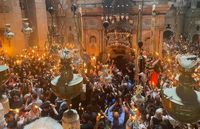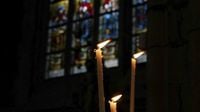On April 19, 2025, the annual miracle occurred in Jerusalem as the Holy Fire descended in the Church of the Holy Sepulchre, also known as the Church of the Resurrection of Christ, on Great Saturday, the eve of Orthodox Easter. This sacred event, which has been a tradition for centuries, drew thousands of believers who gathered to witness this miraculous occurrence.
The ceremony began at approximately 14:30 local time and was broadcast online for those unable to attend in person. The Jerusalem Patriarch, Theophilus III, led the solemn prayers in the Kuvuklia, the chapel housing the tomb of Jesus Christ. Following these prayers, the Holy Fire descended upon bundles of candles, specifically 33 candles, which symbolize the years Jesus lived on Earth.
The descent of the Holy Fire is a significant event for Orthodox Christians, symbolizing the uncreated light of the Resurrection of Christ. This miracle occurs only on the eve of Orthodox Easter and is a moment of deep spiritual significance for those who partake in the celebrations.
After the ceremony, Patriarch Theophilus III distributed portions of the Holy Fire to the worshippers present in the church. This distribution marks the beginning of the Holy Fire's journey to various locations worldwide. It is set to be delivered to Moscow by a delegation from the St. Andrew the First-Called Foundation, where it will be used in the Patriarchal Paschal service at the Cathedral of Christ the Savior.
In addition to Moscow, a portion of the Holy Fire will be sent to over 50 dioceses of the Russian Orthodox Church, including border regional centers such as Bryansk, Belgorod, and Kursk. These areas have been under increased scrutiny due to ongoing tensions and attacks from Ukrainian forces. The delivery of the Holy Fire to these regions is seen as a source of hope and spiritual support for the local communities.
Furthermore, lamps containing the Holy Fire will be delivered to 15 churches across Moscow, allowing parishioners to light their lamps during Holy Week, a time of reflection and preparation for Easter. This practice underscores the communal aspect of the celebration, as believers come together to share in the light of the Holy Fire.
Interestingly, while the Holy Fire will be distributed widely, its delivery to Kyiv is expected to occur without much fanfare. This is due to the official stance of the Jerusalem Orthodox Church, which does not recognize the schismatic Orthodox Church of Ukraine (PCU). The complexities surrounding this recognition reflect broader tensions within the Orthodox community.
In a related development, authorities in Moldova disrupted the planned trip of Bishop Markell of the Moldovan Metropolitanate of the Russian Orthodox Church, who was set to deliver the Holy Fire to his diocese for Easter. This incident highlights the ongoing challenges faced by religious leaders in the region, as political and ecclesiastical tensions continue to influence their activities.
The Holy Fire's descent and distribution have always been a moment of unity and celebration for Orthodox Christians, transcending borders and uniting believers in their faith. As the Holy Fire travels from Jerusalem to various locations, it carries with it a message of hope, renewal, and the promise of resurrection.
As the faithful light their lamps with this sacred fire, they are reminded of the profound significance of the Resurrection and the light it brings into the world. The Holy Fire serves as a beacon of faith, illuminating the path for believers as they navigate the challenges of their daily lives.
In conclusion, the descent of the Holy Fire in Jerusalem remains a powerful symbol of faith and unity among Orthodox Christians worldwide. As it spreads across nations and communities, it reinforces the enduring message of Easter and the promise of new beginnings.





